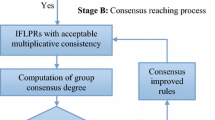Abstract
In this paper, we investigate group decision making problems where the decision information given by decision makers takes the form of interval fuzzy preference relations. We first give an index to measure the similarity degree of two interval fuzzy preference relations, and utilize the similarity index to check the consistency degree of group opinion. Furthermore, we use the error-propagation principle to determine the priority vector of the aggregated matrix, and then develop an approach to group decision making based on interval fuzzy preference relations. Finally, we give an example to illustrate the developed approach.
Similar content being viewed by others
References
Arrow, K. J. (1966). Social Choice and Individual Values. Academic Press, New York
Bouchon-Meunier, B. B. & Foulloy, L. et al. (2003). Intelligent Systems for Information Processing. Elsevier Science, Amsterdam
Chiclana, F. & Herrera, F. et al. (2001). Integrating multiplicative preference relations in a multipurpose decision-making model based on fuzzy preference relations. Fuzzy Sets and Systems, 122: 277–291
Chiclana, F. & Herrera, F. et al. (1998). Integrating three representation models in fuzzy multipurpose decision making based on fuzzy preference relations. Fuzzy Sets and Systems, 97: 33–48
Fodor, J. & Roubens, M. (1994). Fuzzy Preference Modelling and Multicriteria Decision Support. Kluwer Academic Publishers, Dordrecht
Herrera, F. & Herrera-Viedma, E. et al. (2000). A fusion approach for managing multi-granularity linguistic term sets in decision making. Fuzzy Sets and Systems, 114: 43–58
Herrera-Viedma, E. & Herrera, F. et al. (2004). Some issues on consistency of fuzzy preference relations. European Journal of Operational Research, 154: 98–109
Hwang, C.L. & Yoon, K. (1981). Multiple Attribute Decision Making: Methods and Applications. Springer, Berlin
Kacprzyk, J. & Fedrizzi, M. (1990). Multiperson Decision Making Models Using Fuzzy Sets and Possibility Theory. Kluwer Academic Publishers, Dordrecht
Kacprzyk, J. (1986). Group decision making with a fuzzy linguistic majority. Fuzzy Sets and Systems, 18: 105–118
Lipovetsky, S. & Conklin, W.M. (2002). Robust estimation of priorities in the AHP. European Journal of Operational Research, 137: 110–122
Nurmi, H.(1981). Approaches to collective decision making with fuzzy preference relations. Fuzzy Sets and Systems, 6: 249–259
Orlovski, S. A. (1978). Decision-making with a fuzzy preference relations. Fuzzy Sets and Systems, 1: 155–167
Tanino, T. (1984). Fuzzy preference orderings in group decision making. Fuzzy Sets and Systems, 12: 117–131
Xu, C. F. & Geng, W. D. et al. (2000). A fuzzy neural network method for the fusion of communication intercept information. Journal of Computer Research and Development. 37(10): 1212–1217 (in Chinese)
Xu, C. F. & Geng, W. D. et al. (2001). Multi-hierarchical blackboard model for communication intercept information fusion. Acta Electronica Sinica, 29(3): 361–363 (in Chinese)
Xu, R. N. & Zhai, X. Y. (1992). Extensions of the analytic hierarchy process in fuzzy environment. Fuzzy Sets and Systems, 52: 251–257
Xu, Z. S. & Da, Q. L. (2005). A least deviation method to obtain a priority vector of a fuzzy preference relation. European Journal of Operational Research, 164: 206–216
Xu, Z. S. (1999). Study on relation between two classes of scales in AHP. Systems Engineering — Theory & Practice, 19(7): 97–101 (in Chinese)
Xu, Z. S. (2001a). Algorithm for priority of fuzzy complementary judgment matrix. Journal of Systems Engineering, 16(4): 311–314 (in Chinese)
Xu, Z. S. (2001b). A practical method for priority of interval number complementary judgment matrix. Operations Research and Management Science, 10(1): 16–19 (in Chinese)
Xu, Z. S. (2004). Uncertain Multiple Attribute Decision Making: Methods and Applications. Tsinghua University Press, Beijing (in Chinese)
Yager, R. R. & Kacprzyk, J. (1997). The Ordered Weighted Averaging Operators: Theory, Methodology and Applications. Kluwer Academic Publishers, Norwell
Yoon, K. (1989). The propagation of errors in multiple-attribute decision analysis: a practical approach. Journal of the Operational Research Society, 40: 681–686
Author information
Authors and Affiliations
Corresponding author
Additional information
This work was partly supported by National Natural Science Foundation of China (60573056). Zheijiang Provincial Natural Science Foundation of China (Z106335, Y105090), Zhejiang Provincial Scientific and Technological Project of China (2006C30030) and Huzhou Municipal Scientific and Technological Project of China (2006GG03).
Yunliang Jiang is an Associate Professor of the School of Information Engineering of Huzhou University, and a Ph.D. Candidate of the College of Computer Science of Zhejiang University, China. He obtained the B.S. degree in Mathematics from Zhejiang Normal University in 1989 and the M.E. degree in Computer Science and Technology from Zhejiang University in 1997, respectively. His research interests include information fusion, artificial intelligence, and geographic information system. He has published over 20 papers in journals such as Lecture Notes in Artificial Intelligence, Lecture Notes in Computer Science, Pattern Recognition and Artificial Intelligence (in Chinese), and others.
Rights and permissions
About this article
Cite this article
Jiang, Y. An approach to group decision making based on interval fuzzy preference relations. J. Syst. Sci. Syst. Eng. 16, 113–120 (2007). https://doi.org/10.1007/s11518-006-5026-2
Issue Date:
DOI: https://doi.org/10.1007/s11518-006-5026-2




